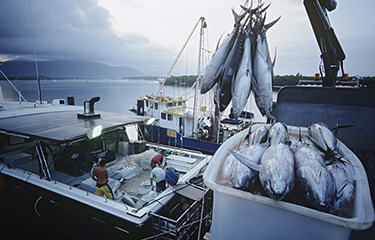The Australian government has announced a new network of air freight service providers and freight forwards to bring the country's goods to foreign markets.
Fifteen airlines and 55 freight forwarders now belong to the International Air Freight Mechanism, which more than 560 Australian businesses are currently utilizing, three weeks into the program's launch, according to a press release from the Australian Fisheries Management Authority. Deputy Prime Minister and Minister for Infrastructure, Transport, and Regional Development Michael McCormack said the network is geared toward helping Australian exporters reestablish their global supply chains.
“The COVID-19 crisis has led to major air freight shortages and disrupted supply chains around the world,” McCormack said. “Appointment of these airlines and freight forwarders will help kick-start regular cost-effective services to key export markets and enhance the capacity for full freight flights of agricultural products from regional locations. We’ve already seen lobster from Western Australia, lamb from Victoria, and salmon from Tasmania shipped to international ports and markets. The quicker we can get our products off the farm and onto airplanes, the more Australian jobs we can save and the quicker our agricultural exporters can bounce back.”
Assistant Minister for Forestry and Fisheries Jonno Duniam said more than 120 seafood exporters have made inquires into the initiative.
“With demand starting to return, this network will be critical to helping our seafood exporters to reestablish themselves in key markets around the world,” Duniam said.
Tuna Australia CEO Davis Ellis told SeafoodSource that it will be very important for tuna producers to maintain a presence in international markets, especially the Japanese market after the southern bluefin tuna longline season starts later this year.
“Subsidized dedicated cargo planes flying direct from Sydney to Japan will be very important when our southern bluefin tuna longline season starts later this year,” he said.
The member businesses main export markets are the U.S. and Japan. and through the Australian government freight assistance program they can send products to the West Coast of the United States – via repatriation flights – with QANTAS and Virgin Airlines while, United Airlines has also opened up a freight route to the U.S.
“However, accessing the Japanese market is challenging, as there are no direct flights from Australia and New Zealand,” Ellis said.
Ellis added that the tuna industry in Australia has been hit hard by the COVID-19 pandemic.
“COVID-19 has changed the way we fish as the amount of air freight space has decreased dramatically,” he said.
For the industry, that means shorter fishing trips, and dealing with meeting tight air-freight schedules as air space is extremely limited due to the liminted number of flights currently leaving the country.
“Some vessels are tied up, while other vessels fish when catch returns are better. Some fishing has been targeted towards species that freeze well for the canned tuna market,” Ellis said.
He added that both international and domestic markets have softened due to restaurant closures worldwide.
Ellis said that some operators have reported Japanese market prices for fresh fish has dropped between 35 to 50 percent, while the amount of frozen fish offered on the auction floor has reduced by 50 percent.
In the domestic market, he said prices and demand dropped by 50 percent in the lead up to Easter, and 80 percent for suppliers that service restaurants. Prices are continuing to fall as more product is landed on the domestic market, he added.
Ellis expressed appreciation for the assistance provided by the Australian government through a waiver of management levies and a job-keeper payment, but said that it wasn’t enough.
“We need to ensure the job-keeper program is extended to all highly skilled employees, so they are retained in our sector,” he said. “At the moment the majority of producers are hanging in there, but for how long is the question? Unfortunately, there have been job losses in the processing arm of vertically integrated business and where vessels have been tied up.”
He added that while the industry might face “a long road back” to recovery, he remains optimistic for the future of the business.
“We are learning how to communicate effectively in isolation, and many new concepts and ideas are being discussed to future proof our food-producing sector,” Ellis said. “This will include developing domestic and international markets.”
Photo courtesy of sirtravelalot







